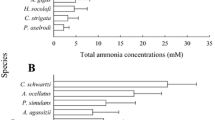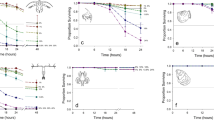Abstract.
The objective of this study was to provide a database of the incipient lethal concentrations for reduced dissolved oxygen (DO) for selected marine and estuarine species including 12 species of fish, 9 crustaceans, and 1 bivalve. All species occur in the Virginian Province, USA, which is a cold temperate region. The study period was August 1987 to September 1995. Standard bioassay procedures were employed, with most tests being of 4-day duration. Up to eight lethal concentrations (LCs) between LC05 and LC95 were estimated. The study provides four general conclusions about determining lethal thresholds of low DO for these organisms. First, the concentration response curve of most species did not change greatly beyond day 1 of the exposure with the exception of crustacean larvae, which were usually more sensitive on day 4, possibly due to molting. Second, acute LC50 values (1- to 4-day) for low DO were influenced by life-stage and habitat, with pelagic larvae generally being the most sensitive and benthic juveniles the least. Species mean LC50 values ranged from 1.4 to 3.3 mg l–1 for larvae, 1.0 to 2.2 mg l–1 for postlarvae, and 0.5 to 1.6 mg l–1 for juveniles. No intraspecific differences in LC50 were detected between larval stages in crustaceans or with age in larval fishes. The response range between LC05 and LC95 was narrowest for the least sensitive organisms (0.6 mg l–1), and broadened with sensitivity. The mean LC10:LC50 ratio for all species was 1.32 for larvae and juveniles, and 1.36 for postlarvae. The ratio for postlarvae represents only four species, and hence is not considered different from the other life stages. Third, variability increased with increased species and life stage sensitivity to low DO, and with endpoints of LC15 and below, which reduces the certainty of some of these results. Lastly, no influence of temperatures between 20°C and 30°C was detected in a small set of tests with thermally acclimated crustacean larvae. This data set has been used to describe protection limits for juvenile and adult survival, and for larval recruitment for the case of persistent (≥24 h) low DO for estuarine and coastal waters of the Virginian Province, USA.
Similar content being viewed by others
Author information
Authors and Affiliations
Additional information
Electronic Publication
Rights and permissions
About this article
Cite this article
Miller, .D., Poucher, .S. & Coiro, .L. Determination of lethal dissolved oxygen levels for selected marine and estuarine fishes, crustaceans, and a bivalve. Marine Biology 140, 287–296 (2002). https://doi.org/10.1007/s002270100702
Received:
Accepted:
Issue Date:
DOI: https://doi.org/10.1007/s002270100702




